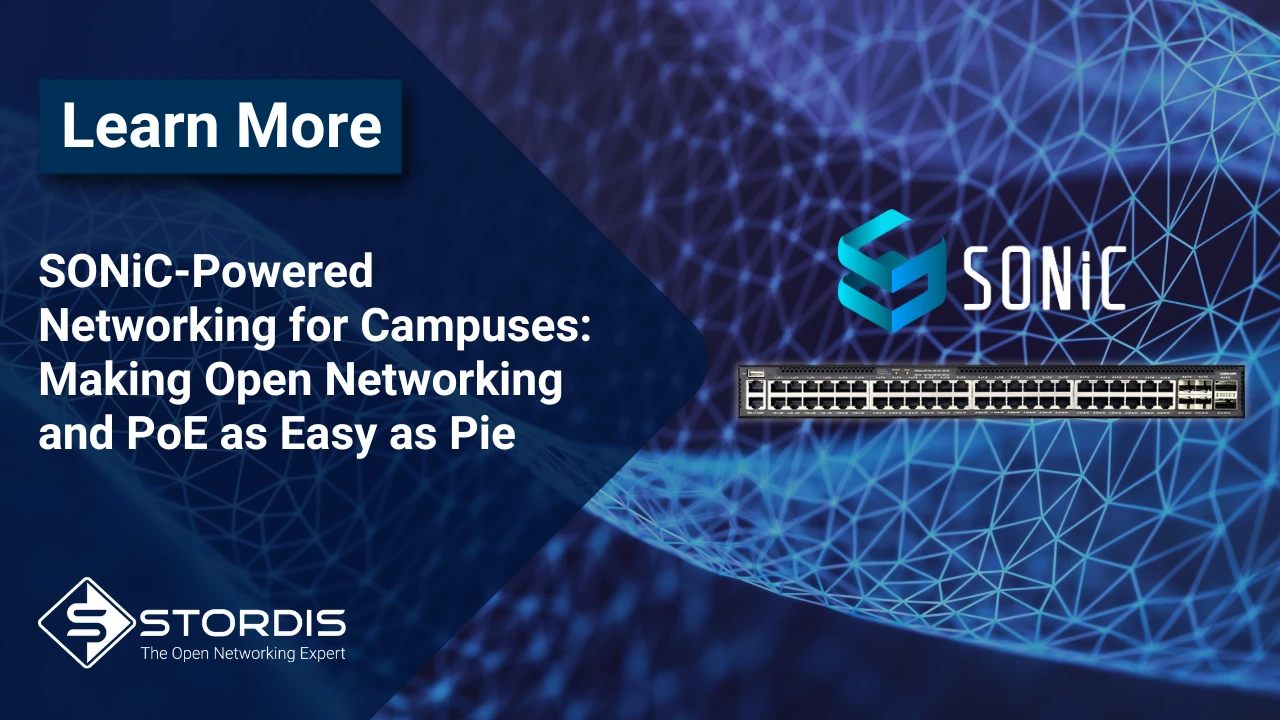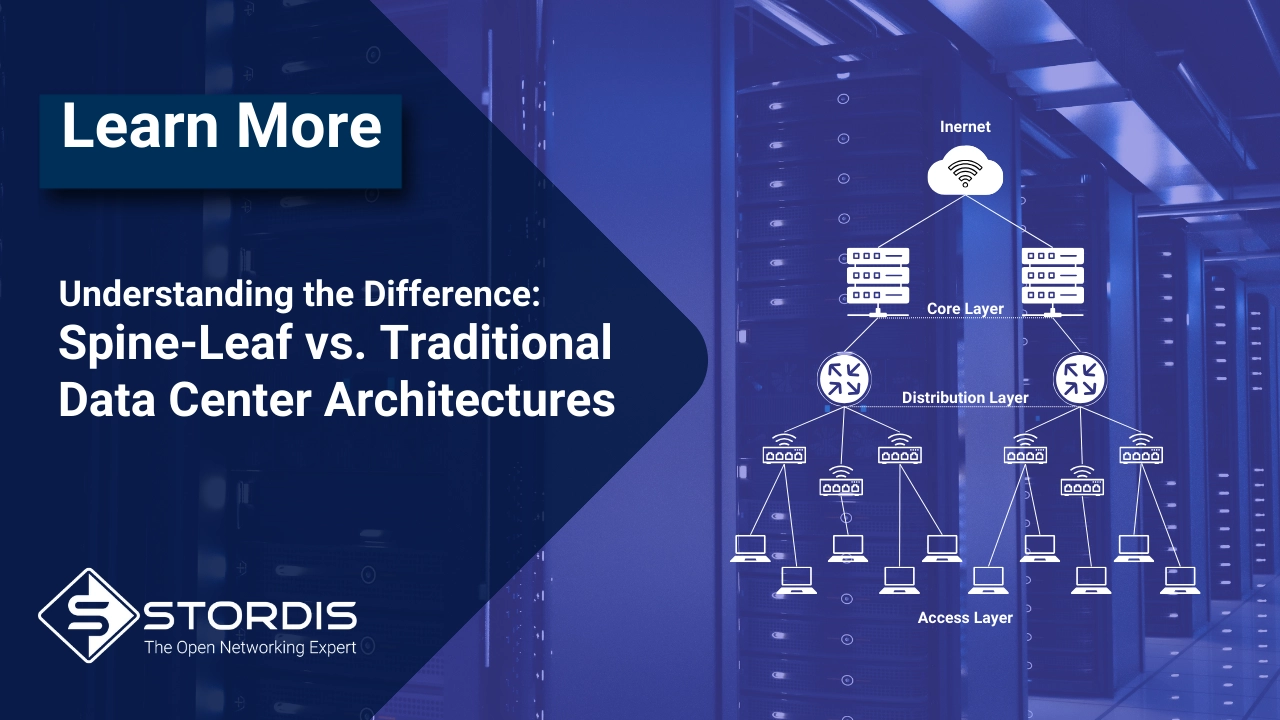- You have no items in your shopping cart
- Continue Shopping
SONiC-Powered Networking for Campuses: Making Open Networking and PoE as Easy as Pie

The networking landscape has been rapidly evolving, thanks to the growing demand for open networking and disaggregation. As network operators and data center managers seek to modernize their infrastructures, they are increasingly turning to solutions that provide flexibility, scalability, and ease of management. One such offering is the Enterprise SONiC Distribution by Broadcom, a robust and commercially supported version of the open-source SONiC network operating system (NOS). In this blog post, we’ll explore the various packages available within the Enterprise SONiC Distribution, with a special focus on the Campus Package and Power over Ethernet (PoE) use cases.
Enterprise SONiC Distribution by Broadcom: Packages Overview
Broadcom’s Enterprise SONiC Distribution offers a comprehensive suite of packages to cater to various networking environments and use cases. These include:
- Cloud Base Package: Designed for data center fabric underlay use cases, it includes essential features like eBGP, ZTP, programmatic API, QoS, ACL, and security features such as TACACS+. It also offers base telemetry features like Thresholds and Snapshots (BST).
- Cloud Advanced Package: Building on the Cloud Base Package, it adds Inband Flow Analyzer (IFA, version 2.0), Tail Stamping, Drop Monitor, and Linux PTP (KNETSync).
- Enterprise Base Package: Tailored for data center fabric underlay and overlay use cases, it offers features such as eBGP, ZTP, programmatic API, QoS, ACL, BGP EVPN, VXLAN, and more. It also includes base telemetry features like Thresholds and Snapshots (BST).
- Enterprise Advanced Package: Expanding on the Enterprise Base Package, it incorporates Inband Flow Analyzer (IFA, version 2.0), Tail Stamping, Drop Monitor, Linux PTP (KNETSync), and the Broadcom Debug Tool.
- Campus Package: Specifically designed for campus-specific platforms, it extends the L2/L3 features to support PoE, PoE+, and PoE-bt, port access control, LLDP-MED, port security, digital optical monitoring, time domain reflectometry, EVPN VXLAN, and more.
Exploring the Campus Package
The Campus Package is designed to cater to the unique needs of campus environments, providing a versatile solution for connecting edge devices and data centers. It is particularly useful in situations where campus devices such as POS systems, thin clients, and security cameras need to be connected to an existing data center infrastructure.
One of the key advantages (and a simply must) of the Campus Package is the support for Power over Ethernet (PoE), a technology that simplifies network deployments by delivering both power and data over a single Ethernet cable. By incorporating PoE, PoE+, and PoE-BT, the Campus Package enables seamless integration of various devices while reducing the need for additional power infrastructure.
To further demonstrate the capabilities of open networking hardware compatible with the Broadcom SONiC, let’s take a closer look at Edgecore’s offerings. Edgecore is one of the vendors who offer open networking hardware with support for different PoE standards, making them a great choice for campus networks.
Edgecore Hardware with PoE Support:
1. AS4630-54PE: This platform comes with 48x1G, 4x25G, and 2x100G ports, with PoE, PoE+, and PoE-BT support. It has been fully supported since the 3.5.0 release.


2. AS4630-54TE (MGMT): Although this model doesn’t feature PoE support, it’s worth mentioning as it offers a variety of ports including 48x1G, 4x25G, and 2x100G. It has been fully supported since the 4.0.0 release.


3. AS4630-54NPE: This platform is equipped with 36x10G, 12x10G, and 4x25G ports, with support for PoE, PoE+, and PoE-BT. Full support is available in the 4.1.1 release, which is expected to arrive in July 2023.


By adopting Edgecore’s open networking hardware, network operators can leverage the benefits of the Campus Package to create a seamless, efficient network infrastructure, meeting the specific needs of campus environments.
I’m sure that you are familiar with PoE, but let’s make a short review and summary of its use cases. PoE has become increasingly important for modern networks, particularly in campus environments where devices need to be deployed in hard-to-reach locations. Some noteworthy use cases include:
- Wireless Access Points: PoE simplifies the deployment of wireless access points by eliminating the need for separate power sources, making it easier to place them in strategic locations for optimal coverage.
- IP Cameras: Security cameras often need to be installed in remote or hard-to-reach areas, making PoE an ideal solution for powering these devices while ensuring a stable data connection.
- IP Telephony: As businesses transition to IP telephony, PoE enables the deployment of power-hungry IP phones without the need for separate power connections, simplifying the installation process and IoT Devices: The Internet of Things (IoT) is driving the proliferation of connected devices across campuses, including sensors, actuators, and controllers. PoE provides a reliable and cost-effective way to power these devices while ensuring seamless data connectivity.
- Lighting Systems: PoE-enabled LED lighting systems can be easily integrated into the network infrastructure, enabling centralized control and monitoring, as well as energy-saving features such as occupancy sensing and daylight harvesting.
- Digital Signage: PoE can be used to power digital signage displays, ensuring a reliable connection for content delivery while reducing the need for additional power outlets.
Are you using PoE? How do you see the needed budget for implementation? Total budget is definitely important but it’s also essential to consider the various types of PoE:
IEEE has released several PoE standards, including IEEE802.3af (standard PoE), IEEE802.3at (PoE+), and IEEE802.3bt (PoE++), which regulate power delivery to PDs. Understanding these standards is crucial for network administrators to ensure compatibility and efficient power management.
- IEEE 802.3af (Standard PoE): With a supply voltage of 44-57V and a supply current of 10-350mA, this standard provides a maximum power output of 15.4W per port. The minimum guaranteed power available at the PD is 12.95 watts per port, suitable for VoIP phones, sensors, and more.
- IEEE 802.3at (PoE+): This updated standard is backward-compatible with standard PoE and provides up to 30W of power per port. The minimum output power assured is 25W, supporting devices requiring more power, such as LCD displays, biometric sensors, and tablets.
- IEEE 802.3bt (PoE++): The latest PoE standard defines Type 3 (PoE++) and Type 4 (higher-power PoE) powering/wattage standards. Both types increase the maximum PoE power by delivering more power through two or more pairs of Ethernet cables. These modes are backward compatible with 802.3af and 802.3at and support devices with higher power requirements like video conferencing systems, laptops, and TVs.
Configuration Examples
Now that we have covered the basics, let’s dive into some configuration examples to give you an idea of how to configure PoE on a Broadcom SONiC switch. I need to tell you that there is not too much but mostly all what we need, but could be better 😉
! Configure PoE on an interface
interface Ethernet1/1
! Enable PoE
no poe disable
! Set the PoE detection mode to dot3bt followed by Legacy detection
poe detection dot3bt+legacy
! Set the port priority level to high
poe priority high
! Configure PoE on another interface
interface Ethernet1/2
! Enable PoE
no poe disable
! Set the PoE detection mode to dot3bt only
poe detection dot3bt
! Set the port priority level to low
poe priority low
! Reset PSE operation on all ports, if needed
clear poe counters
! Configure power management type for the system
poe power management dynamic
! View the current PoE configuration and system-wide status information
show poe
! View the POE port configuration information for individual ports or all ports
show poe port configuration all
This sample configuration demonstrates how to enable and configure PoE on different interfaces, set the detection mode, port priority level, and power management type for the system. It also shows how to reset PSE operation and view the PoE configuration and status information.
What, in your opinion, is missing in the current PoE configuration? …Personally, I would love to see a simple feature that could set up a schedule with synced calendars to disable PoE on specific ports, such as those connected to VoIP phones. This would help save energy during the night or over the weekend when no one is in the office.
The Enterprise SONiC Distribution by Broadcom provides a flexible and scalable solution for open networking, catering to a wide range of use cases with its various packages. The Campus Package, in particular, offers a comprehensive feature set tailored to the specific needs of campus environments, with its support for different types of Power over Ethernet being a key advantage.
By adopting the Campus Package and using open networking hardware such as Edgecore’s offerings, networking specialists can leverage the benefits of open networking and disaggregation, enabling seamless integration of various devices and creating a more streamlined, efficient network infrastructure. The future of networking is open, and Broadcom’s Enterprise SONiC Distribution is at the forefront of this transformation.
Are you ready to level up your knowledge on Power over Ethernet, campus deployments, and much more? Join our comprehensive “Introduction to Enterprise SONiC” course offered by Route2open Academy.
With our expert instructors guiding you through every step, you’ll learn about SONiC, its installation and setup process, redundancy methods, routing protocols, automation, and troubleshooting. Plus, you’ll have access to our supportive Route2open Forums where you can connect with like-minded individuals and share ideas.
Don’t miss this opportunity to enhance your skills and dive into the world of open networking systems. Click the link below to book your spot and start your journey with the Enterprise SONiC course today:
https://route2open.com/courses/r2o-son-brc-sa-r1-sonic-course/
Let’s build a successful future together with Route2open Academy.

Łukasz Łukowski is the Chief Sales and Marketing Officer for STORDIS. Working with channel partners, product management, business development and his marketing team, Łukasz is spearheading the effort to drive year-over-year revenue growth by more effectively leveraging STORDIS’ channel and alliance partners, particularly in the areas of open networking for data center, enterprise and telecom.
Prior to him joining STORDIS, Łukasz was the Vice President of EMEA Channel Sales and Alliances for Edgecore Networks. Łukasz has over 15 years of experience in the networking industry serving additional two roles as, Active A-Team Ambassador of the Open Networking Foundation (ONF); and a Regional Lead Manager for the Open Compute Project (OCP).
Comments
You might be interested in





